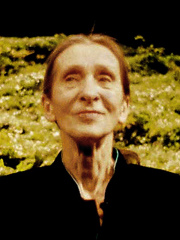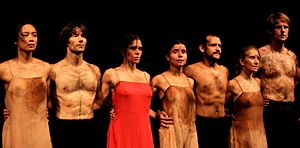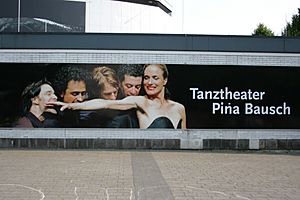Pina Bausch facts for kids
Quick facts for kids
Pina Bausch
|
|
|---|---|

Bausch at the end of Wiesenland in 2009 in Paris.
|
|
| Born | 27 July 1940 Solingen, Germany
|
| Died | 30 June 2009 (aged 68) Wuppertal, North Rhine-Westphalia, Germany
|
| Other names | Philippine Bausch |
| Education |
|
| Occupation | Modern dance choreographer, folk dance choreographer, dancer |
| Organization | Tanztheater Wuppertal |
| Known for | Contemporary dance and choreography |
| Awards |
|
Philippine "Pina" Bausch (born July 27, 1940 – died June 30, 2009) was a famous German dancer and choreographer. A choreographer is someone who creates dance routines. Pina Bausch made a big impact on a dance style called Tanztheater, which means "dance theater."
Her unique style mixed dance moves with interesting sounds and detailed stage designs. She also encouraged her dancers to help create the pieces. Her work greatly influenced modern dance from the 1970s onwards. Pina Bausch's dances often explored feelings and experiences, especially those related to difficult relationships. She started her own dance company, Tanztheater Wuppertal Pina Bausch, which performs all over the world.
Contents
Early life
Pina Bausch was born in Solingen, Germany. Her parents, August and Anita Bausch, owned a restaurant with rooms for guests. Pina grew up there and started performing for the guests at a very young age. She would dance for them, sometimes even in their rooms while they were reading. Her parents quickly saw her talent.
Dance Career
When Pina was 14, she was accepted into the Folkwangschule, a famous dance school led by Kurt Jooss.
After graduating in 1959, Pina received a scholarship. This allowed her to study at the Juilliard School in New York City in 1960. There, she learned from many great teachers like Antony Tudor and Paul Taylor. Pina quickly began performing with Tudor's company and with Paul Taylor's New American Ballet. She once said that New York was "like a jungle" but also gave her "a feeling of total freedom." She felt she truly found herself during her two years there.
In 1962, Pina joined Jooss's new Folkwang-Ballett (Folkwang Ballet) as a main dancer. She also helped Jooss create many pieces. In 1968, she created her very first dance piece, Fragmente (Fragments). The next year, in 1969, she took over from Jooss as the artistic director of the company.
Tanztheater Wuppertal Pina Bausch
In 1973, Pina Bausch became the artistic director of the ballet at the Wuppertal Opera. She soon made it an independent company, calling it Tanztheater Wuppertal. This company has a large collection of original dance pieces. It regularly travels and performs around the world from its home in Wuppertal.
Some of her most famous works include the thoughtful Café Müller (1985). In this piece, dancers move around the stage, bumping into tables and chairs. Pina often had the dancers perform this with their eyes closed. Another exciting work is Frühlingsopfer (The Rite of Spring) (1975). For this, the entire stage was covered with soil. Pina believed that it was important to create what you believed in, even if it challenged the audience.
Pina's work often explored the theme of relationships. She had a special way of creating her dances. She would ask her dancers questions about their own lives. These questions were about their childhood, feelings in different situations, or even things they disliked. The dancers could answer with gestures, words, or small scenes. This freedom helped them explore their deepest feelings. Pina once said, "There is no book. There is no set. There is no music. There is only life and us." She would then take these answers and combine them to build a larger dance piece.
The way men and women interact was a common theme in her dances. This theme even inspired the movie Talk to Her, directed by Pedro Almodóvar. Her pieces were made of short parts of dialogue and actions, often very dream-like. Repeating actions was also a key part of her style. She explained that "Repetition is not repetition." Doing the same action multiple times can make you feel something completely different by the end. Her big productions often had detailed sets and a mix of different music styles. For example, in Vollmond (Full Moon), half the stage was a giant rocky hill. The music included everything from Portuguese songs to k.d. lang.
In 1983, Pina Bausch acted in Federico Fellini's film And the Ship Sails On. Her company, Tanztheater Wuppertal Pina Bausch, first performed in America in Los Angeles in 1984. This was part of the opening of the Olympic Arts Festival.
In 2009, Pina began working with film director Wim Wenders on a 3D documentary about her work. The film, called Pina, was released in 2011 after her death.
Personal life
Pina Bausch was married to Rolf Borzik, who designed sets and costumes for her shows. He passed away in 1980. Later that year, she met Ronald Kay. In 1981, they had a son named Rolf Salomon Bausch.
Awards and Honours
Pina Bausch received many awards for her amazing work. These include the UK's Laurence Olivier Award and Japan's Kyoto Prize. She was given the Deutscher Tanzpreis in 1995 and the Europe Theatre Prize in 1999. In 2008, she received the important Goethe Prize from the city of Frankfurt am Main. She was also chosen as an honorary member of the American Academy of Arts and Sciences in 2009.
In 2012, some of Pina Bausch's works were performed as a special event for the Cultural Olympiad in London. This happened before the Olympic Games 2012. These works were created when Pina visited and stayed in 10 different places around the world between 1986 and 2009.
Death
Pina Bausch passed away on June 30, 2009, in Wuppertal, Germany. She was 68 years old and died from cancer, which was diagnosed just five days before. Her son, Salomon, survived her.
Tributes
After her death, many artists honored Pina Bausch. In 2010, the dance company Les Ballets C de la B performed a show called Out of Context – for Pina. It was dedicated to her memory. The choreographer Sidi Larbi Cherkaoui and dancer Shantala Shivalingappa also dedicated their 2010 work 'Play' to Pina.
Wim Wenders' documentary, Pina, released in 2011, is also dedicated to her memory.
Influence on other artists
Pina Bausch's unique style influenced many other artists. The famous musician David Bowie was inspired by her work when he designed his 1987 Glass Spider Tour. He wanted to combine theater and modern dance, using Pina's early work as a guide. The singer from Florence + The Machine was also deeply influenced by Pina's dances. She felt that Pina's work showed "the human condition in a way that I’ve never seen before."
Influence on popular culture
Pina Bausch's work has even appeared in popular culture. For example, promotional videos for the TV show American Horror Story: Coven included a scene that looked very similar to Pina Bausch's dance piece Blaubart. Both the performance and the TV episode showed women appearing to float on walls, defying gravity.
Works
The table below lists some of Pina Bausch's works since 1973. Many of her early works were simply called Tanzabend (Dance Evening) because she often chose the final title later.
| Year | Title | Translation | Music |
|---|---|---|---|
| 1973 | Fritz | by Gustav Mahler and Wolfgang Hufschmidt | |
| 1973 | Iphigenie auf Tauris | Iphigenia in Tauris | Gluck's opera Iphigenie auf Tauris |
| 1974 | Zwei Krawatten | Two ties | |
| 1974 | Ich bring' dich um die Ecke | I'll do you in | Dance music after old Schlager |
| 1974 | Adagio | Adagio | Mahler's Five songs |
| 1975 | Orpheus und Eurydike | Gluck's opera Orpheus und Eurydike | |
| 1975 | Frühlingsopfer | The Rite of Spring | Stravinsky's ballet The Rite of Spring |
| 1976 | Die sieben Todsünden | The Seven Deadly Sins | The Seven Deadly Sins, music: Kurt Weill, words: Bertolt Brecht |
| 1977 | Blaubart | Bluebeard | Bartók's opera Bluebeard's Castle |
| 1977 | Komm tanz mit mir | Come dance with me | old folk songs |
| 1977 | Renate wandert aus | Renate emigrates | Schlager, Songs, Evergreens |
| 1978 | Er nimmt sie an der Hand und führt sie in sein Schloss, die anderen folgen ... | He takes her by the hand and leads her into the castle, the others follow ... | |
| 1978 | Café Müller | by Henry Purcell | |
| 1978 | Kontakthof | Court of contact | Schlager of the 1930s |
| 1979 | Arien | Arias | by Beethoven, Comedian Harmonists, Mozart, old Italian arias |
| 1979 | Keuschheitslegende | Legend of chastity | by Nino Rota, Robin/Styne, George Gershwin, and others |
| 1980 | 1980 – Ein Stück von Pina Bausch | 1980 A piece by Pina Bausch | Old English folk songs, Shakespeare songs, Comedian Harmonists, Judy Garland |
| 1980 | Bandoneon | Tangoes, sung by Carlos Gardel | |
| 1982 | Walzer | Waltz | by Edith Piaf, Tino Rossi |
| 1982 | Nelken | Carnations | by Franz Schubert, George Gershwin, Sophie Tucker |
| 1984 | Auf dem Gebirge hat man ein Geschrei gehört | On the mountain a cry was heard | by Heinrich Schütz, Henry Purcell, Felix Mendelssohn, Irish pipe music, Billie Holiday |
| 1985 | Two Cigarettes in the Dark | by Monteverdi, Brahms, Beethoven, Bach, Hugo Wolf, Purcell, Ben Webster | |
| 1986 | Viktor | Folk music from many countries, medieval dance music, Russian Waltz, music from New Orleans, dance music of the 1930s, music by Tchaikovsky, Dvořák | |
| 1987 | Ahnen | Suspecting | |
| 1989 | Palermo Palermo | ||
| 1991 | Tanzabend II | Dance Evening II | |
| 1993 | Das Stück mit dem Schiff | The Piece with the Ship | |
| 1994 | Ein Trauerspiel | A Tragedy | |
| 1995 | Danzón | ||
| 1996 | Nur Du | Only you | |
| 1997 | Der Fensterputzer | The window washer | |
| 1998 | Masurca Fogo | ||
| 1999 | O Dido | ||
| 2000 | Wiesenland | Meadowland | |
| 2000 | Kontakthof – Mit Damen und Herren ab 65 | Kontakthof – with men and women of age 65 and up | |
| 2001 | Água | Portuguese for "Water" | |
| 2002 | Für die Kinder von gestern, heute und morgen | For the children of yesterday, today, and tomorrow | |
| 2003 | Nefés | Turkish for "Breath" | |
| 2004 | Ten Chi | ||
| 2005 | Rough Cut | ||
| 2006 | Vollmond | Full Moon | |
| 2007 | Bamboo Blues | ||
| 2008 | Sweet Mambo | ||
| 2008 | Kontakthof – Mit Teenagern ab 14 | Kontakthof, with teenagers 14 years and up | |
| 2009 | ... como el musguito en la piedra, ay si, si, si ... | ... like the moss on the stone ... |
Filmography
Pina Bausch's work has been featured in several films and documentaries:
- 1983 And the Ship Sails On. A drama film directed by Federico Fellini.
- 1983 Un jour Pina m'a demandé. A TV documentary by Chantal Akerman.
- 2002 Talk to Her. A drama film directed by Pedro Almodóvar.
- 2011 Pina – Dance Dance Otherwise We Are Lost. A documentary directed by Wim Wenders.
Images for kids
See also
 In Spanish: Pina Bausch para niños
In Spanish: Pina Bausch para niños






